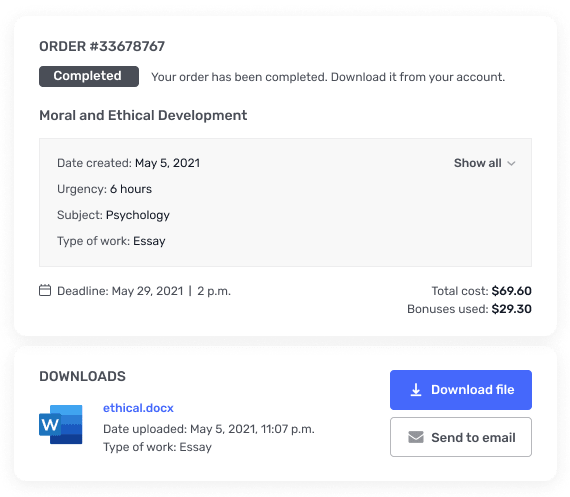Online Exam
Part 1 of 2 – 42.5/
50.0 Points
Question 1 of 40
0.0/ 2.5 Points
Under the theory of due care, under what conditions should
the distribution of a product be strictly controlled?
A. when selling to
an international market
B. when the product
is produced by a monopoly
C. when the product
requires expertise to handle safely
D. when the product
has a universal application
Question 2 of 40
2.5/ 2.5 Points
Some advertisements that are intended to manipulate consumers
violate what right?
A. the right to free
speech
B. the consumer’s
right to be treated as a free and equal rational being
C. the right to
choose between competitors in a free market
D. the right to
personal safety
Question 3 of 40
2.5/ 2.5 Points
Which of the following is considered a valid criticism of
the contract view?
A. Government
regulation hinders its effectiveness.
B. The “invisible
hand” of market forces makes it redundant.
C. The view assumes
that the buyer and seller are equally qualified to evaluate the product.
D. Advertising
effectively negates the validity of the contract.
Question 4 of 40
2.5/ 2.5 Points
Which of the following is considered a valid challenge to
the social cost view?
A. It allows
consumers to sue manufacturers for their own clumsiness or incompetence.
B. It encourages
unsafe use of products in hopes of large settlements.
C. It can be unfair
to companies as it may punish them for unforeseeable effects.
D. It can negatively
impact insurance companies, driving them out of business.
Question 5 of 40
2.5/ 2.5 Points
The __________ theory of a business’s duties to consumers
claims that a business has four main moral duties: the basic duty of (a)
complying with the terms of the sales contract, and the secondary duties of (b)
disclosing the nature of the product, (c) avoiding misrepresentation, and (d)
avoiding the use of duress and undue influence.
A. contractual
B. commercial
C. competitive
D. consumptive
Question 6 of 40
2.5/ 2.5 Points
In the due care theory of manufacturer’s duties, the
relationship between manufacturer and customer can be described as which of the
following?
A. The manufacturer
is in an unequal position to harm and take advantage of the customer.
B. They are equals.
C. The customer is
in an unequal position to place demands on the manufacturer.
D. The manufacturer
and the customer are separated by a regulating body.
Question 7 of 40
2.5/ 2.5 Points
Psychological privacy is best described as:
A. freedom from
being questioned about our opinions and beliefs.
B. the right to
remain silent in a court of law.
C. the right to own
our ideas and inventions.
D. freedom from
having our personal thoughts and beliefs invadeD.
Question 8 of 40
2.5/ 2.5 Points
The _________ of the manufacturer’s duties to consumers is
based on the idea that consumers and sellers do not meet as equals and the
consumer’s interests are particularly vulnerable to being harmed by the
manufacturer.
A. duty to comply
B. contract view
C. consumer
protection clause
D. due care theory
Question 9 of 40
0.0/ 2.5 Points
Which group is considered vulnerable to advertising aimed at
altering desires?
A. parents
B. seniors
C. children
D. corporations
Question 10 of 40
2.5/ 2.5 Points
Which of the following is NOT a strictly ethical criticism
of advertising?
A. It can affect the
consumer’s beliefs.
B. It can manipulate
the desires of children.
C. It can use
deception as a means of improving sales.
D. It can venerate
materialistic values.
Question 11 of 40
2.5/ 2.5 Points
Which of the following is NOT a key component of the right
to privacy?
A. control over who
is disclosing information about oneself
B. control over to
whom information about oneself is disclosed
C. control over what
information about oneself is disclosed
D. control over how
much information about oneself is disclosed
Question 12 of 40
2.5/ 2.5 Points
Which are the three main credit reporting companies?
A. Experian, Credex,
and Your Credit
B. Experian, Real
Credit, and Credibility
C. Experian, Equifax
and Trans Union LLC
D. Experian, Exact
and Specialty
Question 13 of 40
0.0/ 2.5 Points
In the market approach to consumer protection, what would
lead to higher safety standards in consumer products?
A. government
regulation
B. inter-corporate
agreements
C. foreign trade
agreements
D. consumer demand
Question 14 of 40
2.5/ 2.5 Points
What dubious advice does Credit Solutions initially give its
clients?
A. not to pay their
credit cards
B. to sell off all
of their fungible assets
C. to max out their
credit cards
D. to pay off their
mortgage with their credit card
Question 15 of 40
2.5/ 2.5 Points
Which view of customer protection is most opposed to
government intervention?
A. duty of care
theory
B. social cost
theory
C. market theory
D. communist theory
Question 16 of 40
2.5/ 2.5 Points
What is “market power?”
A. the ability for
free markets to self-regulate
B. the energy wasted
through needless competition
C. the ability of
large firms to use their assets to control a market
D. the ability of
marketing campaigns to affect consumer desires
Question 17 of 40
2.5/ 2.5 Points
Caveat emptor is a Latin phrase used to mean what in modern
business?
A. “The customer is
always right.”
B. “You break it,
you buy it.”
C. “Let the buyer
beware.”
D. “Always be
closing.”
Question 18 of 40
2.5/ 2.5 Points
What is a “bait advertisement?”
A. an ad that is
attached to free merchandise
B. an ad that lures
customers into the store through curiosity
C. an ad that
promises an item that is not actually available
D. an ad for
earthworms, mealworms or minnows
Question 19 of 40
2.5/ 2.5 Points
The consumers who think ahead, consider, and watch every
penny they spend, knowing how their choices will affect their preferences are
known as:
A. irrational
utility minimizers
B. rational utility
maximizers
C. rational
consumption maximizers
D. irrational
consumption maximizers
Question 20 of 40
2.5/ 2.5 Points
Which of the following is NOT a necessary aspect of
commercial advertising?
A. addresses a mass
audience
B. communicates to
potential buyers
C. induces the
purchase of a product or service
D. contains
information about the product or service
Part 2 of 2 – Lesson 7 47.5/
50.0 Points
Question 21 of 40
0.0/ 2.5 Points
Which of the following is most responsible for the wage gap
between men and women?
A. education
B. absenteeism
C. work experience
D. none of the above
Question 22 of 40
2.5/ 2.5 Points
Which of the following is a utilitarian argument against
discrimination?
A. Discrimination
leads to an inefficient use of human resources.
B. Discrimination
violates basic human rights.
C. Discrimination
results in an unjust distribution of society’s benefits and burdens.
D. Discrimination
violates the rule of free entry in a free market.
Question 23 of 40
2.5/ 2.5 Points
Affirmative action programs begin with a(n)__________ in an
organization.
A. review of past
discrimination
B. utilization
analysis of the major job classifications
C. compensation analysis
of the major job classifications
D. review of
employee backgrounds
Question 24 of 40
2.5/ 2.5 Points
Kant would argue that humans should be treated as ends in
themselves and never as a means to an enD. With respect to discrimination, this
implies that people should be treated as what?
A. equals
B. property
C. competitors
D. family
Question 25 of 40
2.5/ 2.5 Points
Which is true of discrimination?
A. It must be
intentional.
B. It must have a
negative impact.
C. It must be
individual.
D. It must be
direct.
Question 26 of 40
2.5/ 2.5 Points
Which occupation has the smallest proportion of women
employed?
A. social workers
B. lawyers
C. pilots
D. artists
Question 27 of 40
2.5/ 2.5 Points
What is an affirmative action program?
A. a program to
increase employee morale and thereby improve utility
B. a program through
which ethical behavior is recognized and rewarded
C. a program meant
to correct imbalances in the demographics of a workforce
D. a program aimed
to compensate individuals harmed by a product before they attempt to sue
Question 28 of 40
2.5/ 2.5 Points
Recruitment practices that rely on the word-of-mouth
referrals of present employees will tend to recruit:
A. highly qualified
candidates.
B. a diverse group
of candidates.
C. individuals who
are equal in all relevant respects.
D. from the groups
already represented.
Question 29 of 40
2.5/ 2.5 Points
Critics claim that __________ actually harm(s) women and
minorities by implying that they are so inferior to white males that they need
special help to succeed.
A. on-the-job
training
B.
anti-discrimination policies
C. affirmative
action
D. comparable worth
programs
Question 30 of 40
2.5/ 2.5 Points
In which of the following professions is the largest
disparity in pay between the sexes?
A. healthcare
support
B. construction and
mining
C. sales and related
D. farming, fishing,
and forestry
Question 31 of 40
2.5/ 2.5 Points
Since the jobs women have historically taken pay low wages
and salaries, proponents of ____________ programs attempt not to place women
into higher paying jobs, but to increase the salaries of those jobs where women
currently are employed.
A. Competitive Value
B. Competitive
Position
C. Comparable Worth
D. Comparable Equity
Question 32 of 40
2.5/ 2.5 Points
“It might be true that society as a whole would benefit by
having some group discriminated against” is a/an _____ argument for discrimination.
A. Kantian
B. Utilitarian
C. Capitalist
D. Communist
Question 33 of 40
2.5/ 2.5 Points
Arguments against discrimination are:
A. Utilitarian,
rights, and justice arguments
B. Rights,
entitlements, and fairness arguments
C. Justice and
Kantian arguments
D. Civil and
criminal
Question 34 of 40
2.5/ 2.5 Points
Which of the following is NOT a condition for which
affirmative action can be legally instituted?
A. a manifest racial
imbalance
B. the allocation of
funds of local government for contractors
C. an historic,
persistent, and egregious underrepresentation of women
D. an egregious lack
of diversity in an educational institution
Question 35 of 40
2.5/ 2.5 Points
What is meant by the term “glass ceiling?”
A. a governmental
program requiring upper management to be more transparent to their subordinates
B. the idea that
lower level employees are always watching those above them
C. a metaphor for
the fragility of the hierarchy of a large business
D. an invisible
barrier that prevents advancement to women and minorities
Question 36 of 40
2.5/ 2.5 Points
Discriminatory acts themselves can be categorized according
to the extent to which they are intentional and:
A. manifest racial
imbalance.
B.
institutionalized.
C. persistent.
D. inequitable.
Question 37 of 40
2.5/ 2.5 Points
Affirmative action programs are intended to do what?
A. force companies
to hire women
B. eliminate the
effects of past discrimination
C. make it easier
for new immigrants to get jobs
D. help minority
populations assimilate into the workforce
Question 38 of 40
2.5/ 2.5 Points
An indication of discrimination exists when:
A. a
disproportionate number of a certain group’s members hold less desirable
positions despite their preferences and abilities.
B. a large number of
a certain group’s members are enrolled in a comparable worth program.
C. promotion
decisions are not always based on individual merit.
D. corporate decisions
often have a harmful impact on the interest of employees.
Question 39 of 40
2.5/ 2.5 Points
Which of the following is NOT one of the three basic
elements of discrimination in employment?
A. the decision must
derive from racial or sexual prejudice
B. the decision must
not be the result of a comparable worth program
C. the decision must
not be based on individual merit
D. the decision must
have a harmful impact on the interest of employees
Question 40 of 40
2.5/ 2.5 Points
Which of the following forms of employee discrimination is
NOT legally protected in the United States?
A. discrimination by
ability
B. discrimination by
sex
C. discrimination by
nationality
D. discrimination by
race




